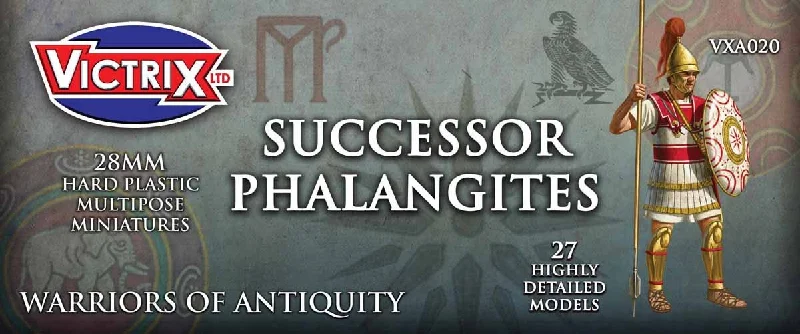- Warriors of Antiquity
- 28mm scale
- 27 Highly detailed plastic figures, multiple pose options
- 6 x body options
- 15 x head options
- 28 x shields
- 24 x spears
- 1 x sword
- 1 x trumpet
- 1 x banner stand
- 9 frames
- Molded in gray.
- Packaging dimensions: 9.0” W x 12.5” H x 1.75” D
- Unpainted figures, assembly with glue and painting required.
This exceptional 27 figure set of 28mm hard plastic Successor Phalangites has superbly detailed figures and a myriad of additional parts allowing hundreds of options when building the figures.
The Macedonian phalanx (Greek: Μακεδονική φάλαγξ) is an infantry formation developed by Philip II and used by his son Alexander the Great to conquer the Achaemenid Empire and defeat armies of other kingdoms. Phalanxes remained dominant on battlefields throughout the Hellenistic period, although wars had developed into more protracted operations generally involving sieges and naval combat as much as pitched battles, until they were ultimately displaced by the Roman legions.
Each phalangite carried as his primary weapon a sarissa, a double-pointed pike over 6 m (18 ft) in length, weighing about 6.6kg (14.5 pounds). The sarissae were carried in two pieces before a battle and then slid together when they were being used. At close range such large weapons were of little use, but an intact phalanx could easily keep its enemies at a distance. The weapons of the first five rows of men all projected beyond the front of the formation, so that there were more spear points than available targets at any given time. Men in rows behind the initial five angled their spears at a 45 degree angle in an attempt to ward off arrows or other projectiles. The secondary weapon was a shortsword called a xiphos. The phalangites also had a smaller and flatter shield than that of the Greek hoplon, measuring about 24 inches and weighing about 12 pounds. The shield was made of bronze plated wood and was worn hung around the neck so as to free up both hands to wield the sarissa. All of the armor and weaponry a phalangite would carry totaled about 40 pounds, which was close to 10 pounds less than the weight of Greek hoplite equipment.
The Hellenistic armies is the term applied to the armies of the successor kingdoms of the Hellenistic period, which emerged after the death of Alexander the Great. After his death, Alexander's huge empire was torn between his successors, the Diadochi (Greek: Διάδοχοι). During the Wars of the Diadochi, the Macedonian army, as developed by Alexander and Philip II, gradually adopted new units and tactics, further developing Macedonian warfare and improving on the tactics used in the Classical era. The armies of the Diadochi bear few differences from that of Alexander, but during the era of the Epigonoi (Ἐπίγονοι, "Successors"), the differences were obvious, favoring numbers over quality and weight over maneuverability. The limited availability of Greek conscripts in the east led to an increasing dependence on mercenary forces, whereas in the west, Hellenistic armies were continuously involved in wars, which soon exhausted local manpower, paving the way for Roman supremacy. The major Hellenistic states were the Seleucid Empire, Ptolemaic Egypt and the Antigonid kingdom (Macedonia). Smaller states included: Attalid Pergamum, Pontus, Epirus, the Achaean League, the Aetolian League, Syracuse, and other states (like Athens, Sparta etc.).

